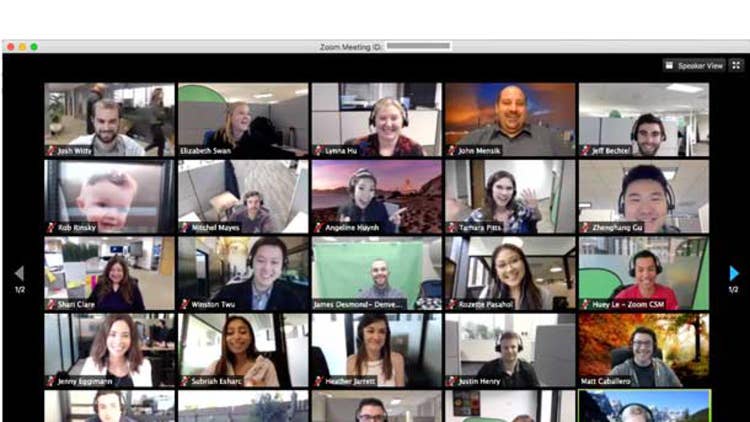Zoom Outages: 5 Reasons Why Zoom Is Experiencing Growing Pains
From a couple of widespread Zoom outages, to security and data privacy concerns, here are five reasons that could explain Zoom‘s growing pains over the last five months.

Testing The Limits
Videoconferencing giant Zoom Video Communications on Monday experienced a service disruption affecting meeting and webinar service for users based in the U.S. and Europe. The outage couldn‘t have come at a worse time as many schools were beginning their first day of virtual learning and employees around the globe continue to work from home.
Zoom has had a busy year. The COVID-19 pandemic in March forced both consumers and business users alike to flock to Zoom to virtually meet and collaborate with colleagues, classmates, friends and family members as the pandemic prompted stay-at-home and quarantine orders around the globe. During the first few months of 2020, the Zoom team said it was working around the clock to support the “tremendous influx of new and different types of users” on the platform. But the sudden and increased demand didn‘t come without issues.
Security and data privacy concerns began to crop up, which caused some businesses and school systems to ban the use of Zoom video. The San Jose, California-based company quickly jumped into action with a 90-day security plan aimed at tackling these issues. Zoom in April picked a new cloud provider, Oracle, right as its first large-scale outage since the pandemic occurred.
While Zoom hasn‘t publicly said what caused the latest outage, the video specialist relies on third-party, public cloud providers to host its services. Users are often relying on home networks to run video services. Scale could also be part of the problem as students return to virtual classes this month.
Here are five reasons that could explain Zoom‘s growing pains over the last five months.

Unprecedented Growth
As the global pandemic forced many employees to work from home and students to distance-learn as schools and universities closed, Zoom saw a “massive increase in demand” for its services in a very short period of time. That uptick in demand required rapid changes to be made by Zoom‘s developers in order to have the scale in place necessary to accommodate millions of new users right away. But scaling up quickly can result in networking or security issues.
According to Downdetector.com, there were more than 15,000 reports of problems with Zoom video as of 9:48 a.m. ET on Monday. The site classified 76 percent of those problems as log-in issues. All other Zoom capabilities, including Zoom Phone, Chat, its conference room connector, cloud recording, meeting telephony services, and the Zoom developer platform were reported as operational.
Zoom also experienced a widescale outage in early April with users on the East Coast of the United States and parts of Europe reporting error messages upon attempting to log in to the Zoom web client. To a lesser extent, the outage was felt in parts of California, Florida, and the Midwest, as well as Malaysia, according to DownDetector.com.

Security Concerns
Zoom has been battling security concerns since the start of the pandemic. Data privacy concerns around the easy-to-use, cloud-based platform have grown since March as cases of teleworking and online classroom hijackings - dubbed “zoombombing” - were being reported. The FBI in March said it received multiple reports of conferences being disrupted by pornographic images, hate images or threatening language.
As a result, Zoom kicked off a 90-day security enhancement plan on April 1 to boost the security of its offerings, address data privacy concerns for customers and partners, and build user trust, according to Zoom‘s CEO Eric Yuan. The 90 days ended on July 1.
During that time, Zoom enacted a 90-day freeze on all features not related to privacy, safety, or security. The company said from April 1-July 1, it released more than 100 new security and privacy features, including Zoom 5.0, an updated platform that includes a support for AES 256-bit GCM encryption, a single icon that contains all security features, and the ability to report users for inappropriate conduct. Zoom is working on rolling out optional end-to-end encryption for all users, not just paid users, as of the end of July.
Despite the changes made from a security standpoint, many organizations, including educational institutions, medical facilities, and solution providers, banned Zoom in favor of video solutions such as Cisco Webex and Microsoft Teams.

The Cloud
While Zoom has not publicly revealed the cause of the outage or if it had to do with its cloud platform, the provider in April announced it had selected Oracle as its cloud infrastructure provider for its core online meeting feature as demand for its services was skyrocketing. A Zoom spokesperson at the time said the company was teaming with Oracle on its latest expansion to provide multi-cloud solutions to its customers.
Zoom leans on third-party, public cloud providers to run its services. In addition to Oracle, Zoom also relies heavily on Amazon Web Services (AWS) and Microsoft Azure cloud infrastructure.

The Network
Zoom video, perhaps more so than any other videoconferencing service, is often run on home or non-enterprise networks. That‘s because it serves both consumer and business users more than competing business-focused video services, such as Cisco Webex, Microsoft Teams, or the now Verizon-owned BlueJeans Networks.
Many businesses turned to Zoom overnight as an easy -- and in the beginning, free -- way of keeping their employees connected. But home networks today that are running video applications must often compete with other users, including multiple people working and learning from home, which could cause issues for bandwidth-intensive, demanding video applications, including latency, jitter, or dropped connections.

The Resolution
Zoom at 9:50 a.m. ET on Monday reported that it had identified the problem that resulted in an outage that was preventing users throughout the U.S. and Europe from accessing its meetings and video webinars capabilities after first acknowledging a problem with its platform about an hour earlier.
The company did not respond to several of CRN‘s requests for comment on the cause behind the Monday outage.
The issue came as many schools began their first days of virtual learning, heavy usage is thought to be the potential cause of the Monday crash, but has not been confirmed by the company.
Zoom‘s service status page as of 1:10pm ET on Monday said: “We have resolved the issue causing some users to be unable to start and join Zoom Meetings and Webinars or manage aspects of their account on the Zoom website.”